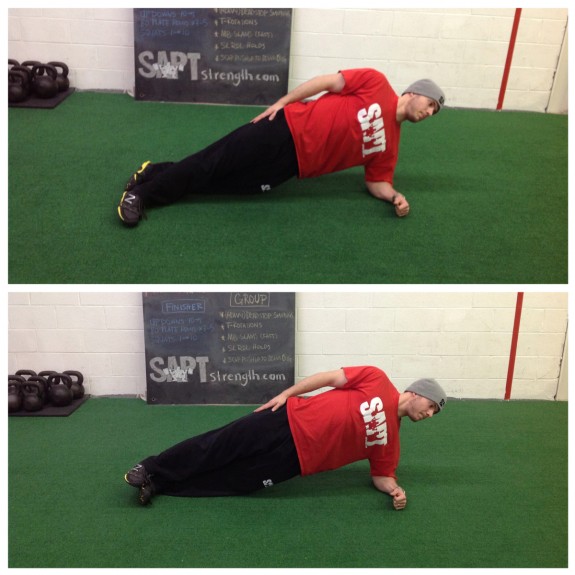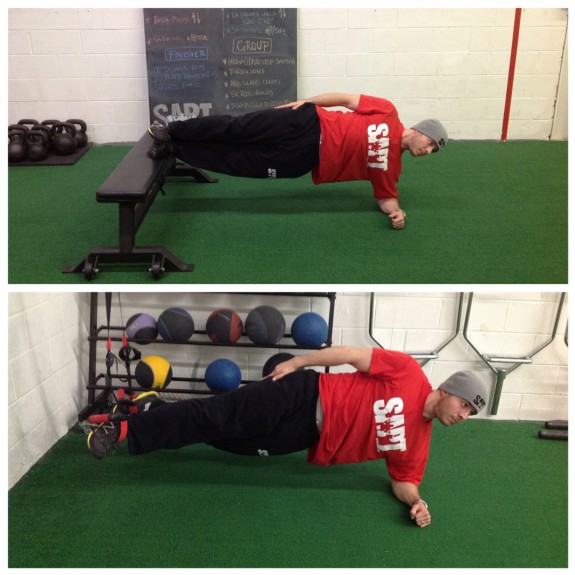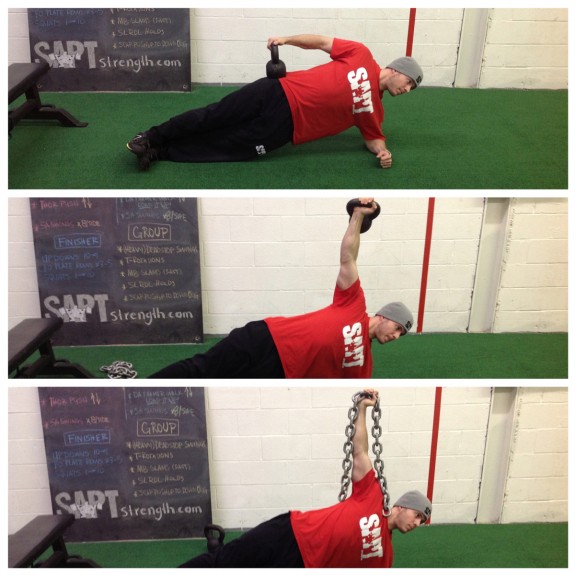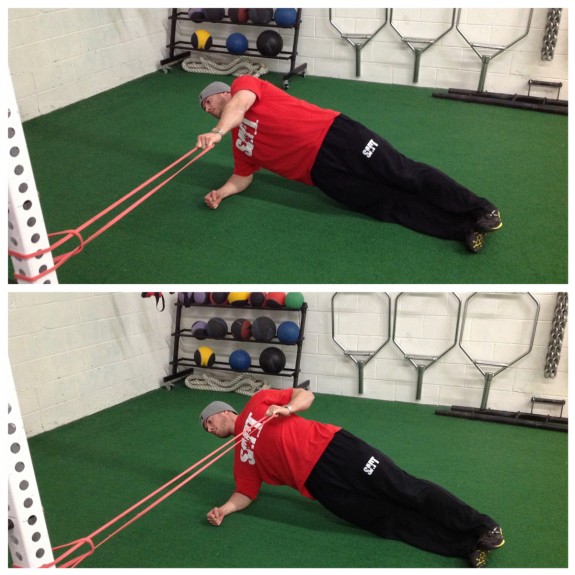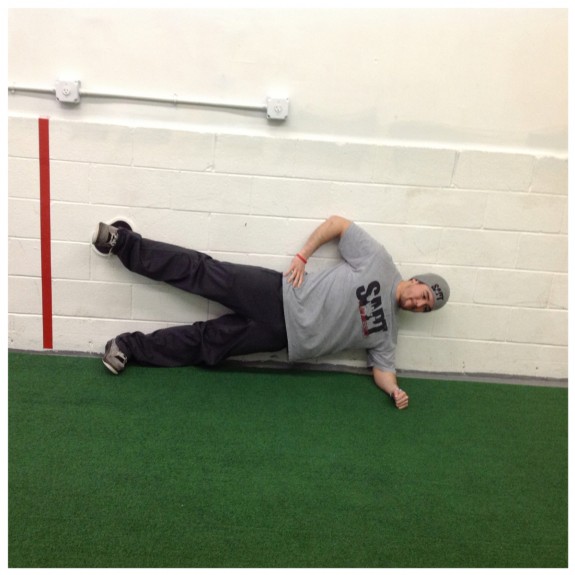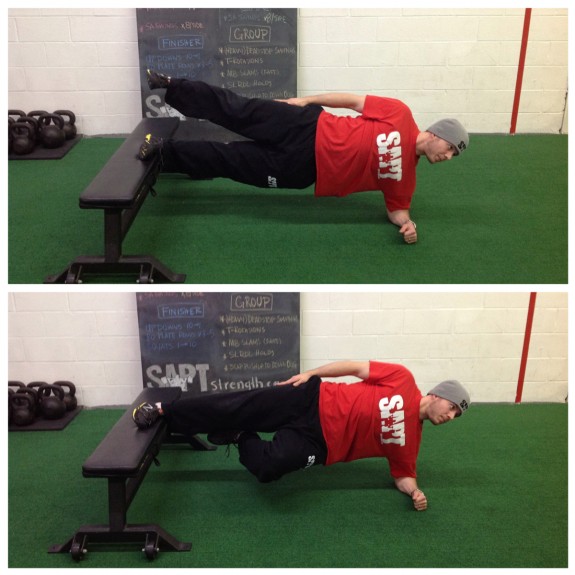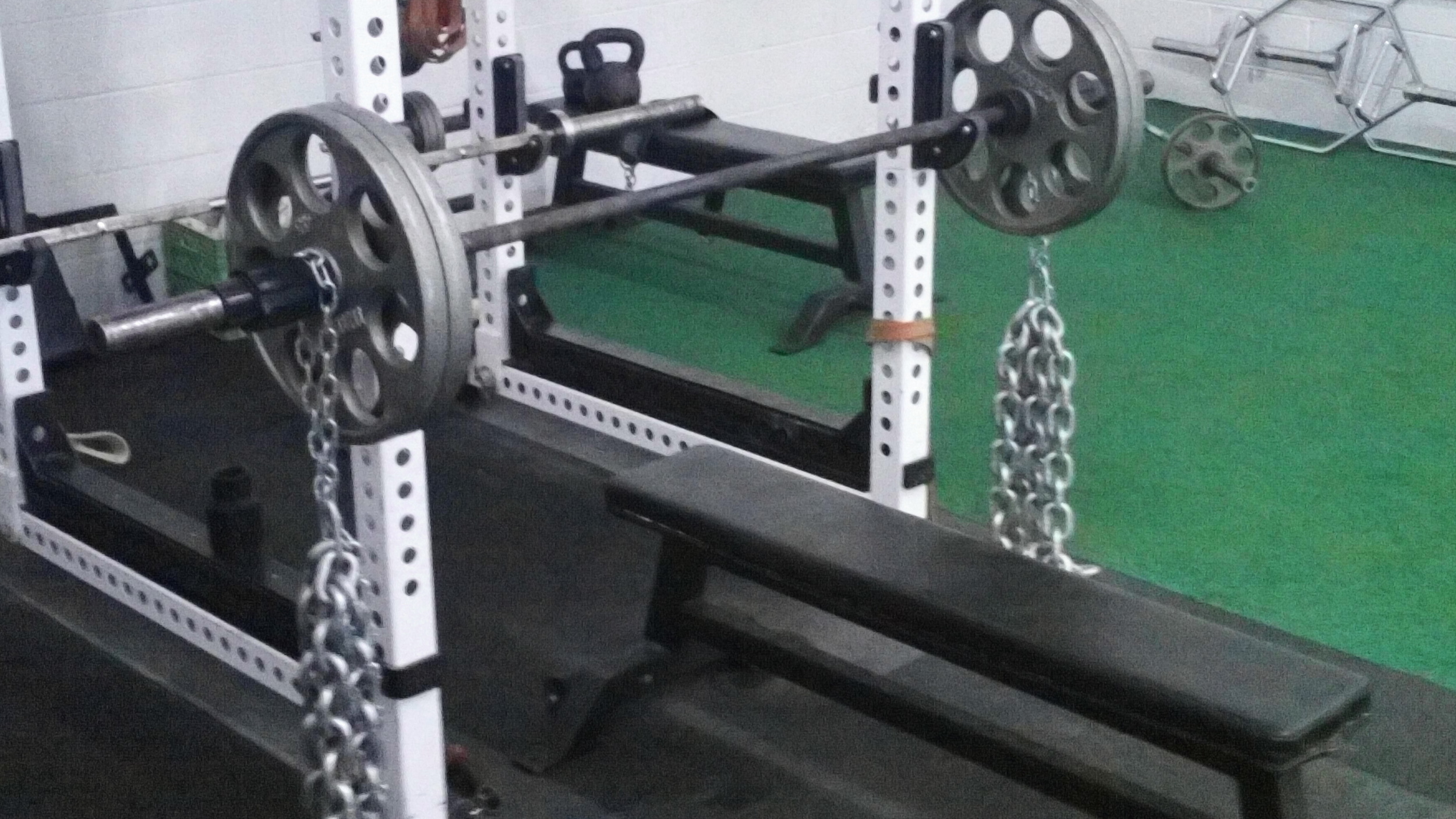For the Overextended Part II
A few months ago I wrote a post on warming up for those with a chronically overextended lumbar spine. Since then I’ve gotten a few requests for a sequel post, so... Without further adieu…
For the Overextended Part II: The Lift
In my first post I discussed “prepping” for the lift for those with exaggerated lordosis. I babbled about targeted stretching, mobilizing, and activation exercises used in conjunction with the idea that it would help “tuck” the hips under a bit more and reduce that ridiculous curve in the lower back that ails us.
For many that'll do the trick. After the warm-up they can feel their abs and glutes engage a bit more throughout their lifting session and they feel much more secure about their lower back health.
However, there are those that need more than a 15 minute warm-up to relieve them of their discomfort caused by the overextension. These might be the people with hip flexors that refuse to let go, erectors in constant spasm, and glutes that seem to have tragically passed away from years of desk work.
For these people with symptoms a bit more severe than the rest, some careful consideration should be taken into not only their warm-up but the structure of the lifting program itself. Here are a few exercises I like to use to fight against the overextension apocalypse.
Lower Body
Front Squats
For improved posture I tend to favor front squats over back squats mainly because it really helps to emphasize t-spine extension. Like I mentioned in my previous post, a hyperlordodic posture is often accompanied by significant kyphosis in the upper back. By focusing on keeping the upper back tight and the elbows up and in, front squats basically become a good way to practice good posture under resistance. (Practice makes permanent!)
Split Squats
Remember to do your split squats with all of the knee health rules in mind (keep the knee tracking straight ahead, try to keep a vertical shin), but add this one: squeeze the glute of your rear leg HARD the entire time. If you really flex that rear buttcheek you will feel a good stretch in that hip flexor as you descend to the bottom position.
Pull-Throughs and Glute Bridges
Keep hammering away at your posterior chain strength and emphasize the “tuck under” with your hips. Pull-throughs with a band or cable column is a great way to train the backside while avoiding any compression on your spine. Also throw in some glute bridges into your actual lift! They shouldn’t be reserved for just the warm-up.
Glute bridging variations are endless:
-Double Leg -Single Leg -Double Leg Concentric with Single Leg Eccentric -With a Barbell -With Chains -With a Barbell AND Chains -Back Elevated -Feet Elevated -Back AND Feet Elevated
Get to 'em!
KB Swings
Same idea as above: POSTERIOR CHAIN WORK. Perfect the hinge and develop incredible hip thrusting power. I recommend getting Kelsey or another well-qualified coach to supervise if you haven’t done them before. A correctly performed swing session can do wonders for your posture, but a bad swing sesh can wreak havoc on your lower back!
Upper Body
½ Kneeling Work
Do standing overhead presses and barbell rows make your lower back cranky? Fear not, and enter the ½ kneeling realm of pushing and pulling. Getting into the ½ kneeling position does a great job of positioning overextended spines back to neutral. Replace some of your pressing movements with single arm ½ kneeling landmine, kettlebell, or dumbbell presses. Then make sure to get your pulling in and grab a band or a cable column to do some ½ kneeling rows as well.
Push-Ups and Inverted Rows
Easy enough right? If you take away the movement from the upper extremities, these exercises become a plank or an isometric glute bridge, respectively. What I mean by that is you MUST make sure you keep your abs tight and your hips (NOT lower back) locked in extension as you do your push-ups and rows. When you feel like you’re starting to arch, call it a set or reset your hips.
Benching…?
Bench pressing can help improve my overextended posture?! No, I doubt it. However, I’m throwing it on here for a couple reasons 1) A lot of us are probably going to bench anyway. 2) It may be part of your team’s strength program for high school, college, or beyond.
Many trainees (including myself) prefer to bench with an arch. It helps to get into a position of better leverage and feels a bit smoother on the shoulders. When setting up to bench with a significant arch there is going to be some extension in the lower back, but you should try your best to emphasize the arch coming from the thoracic spine. If you cannot get into an arched back position on the bench without discomfort you still have options. You can simply bench with less of an arch, and by elevating your feet on weight plates you will be able to get a flatter back posture more comfortably. Another option you have is... don't bench. What?!
Floor Press
Take it to the floor! Bring your feet in and keep your back flat against the ground. That should quench your thirst for supine barbell pressing.
Anterior Core Work
Always throw in some work for your abs. Stronger abs will help pull that pelvis up in the front and decrease that anterior tilt. Anti-rotation presses, reverse crunches, roll-outs with a stability ball or an ab-wheel, and stir-the pots are all good options. One of my favorites is a plank. Boring you say? Load it up! Start stacking plates on your back and try to PR every time.
Fin That’s it for now. Can’t guarantee a part III, but you never know!
15 Variations of the Side Plank
The side plank is one of those exercises I find myself frequently tossing out of my quiver of training options, only to find myself continually coming back to it saying, "Why did I stop doing these again?" Or, "Tell me why I stopped giving these to my athletes?" It's a fantastic exercise that I feel should be imperative in every single beginner program - to teach them core stability, resisting lateral flexion, etc. - but can also be extremely useful as a warm-up or "filler" exercise for more advanced trainees.
Bottom Line: You are never either too novice or too advanced for the side plank, it's just a matter of finding the right fit for you personally.
Here are 15 variations of the good ol' fashioned side plank, be you a beginner or an advanced trainee.
Oh, and don't be a fool like I was during these photos with the extremely grody head positioning. Apparently I didn't want to look Tadashi in the eye as he snapped these; either that, or I felt like looking off into the horizon. The chin should be neutral, or "packed." Geeze, why did that guy in the red demo these, anyway?
Level 1: Short Lever and Torso-Elevated
I personally find the knees bent, or "short lever," variation MUCH better suited for those who are new to training and/or are dealing with low back pain. For whatever it's worth, I've found that, in some cases, elevating the torso even seems to make it harder then doing it on the flat ground.
If I'm working with someone on their first day, and I'm doubtful that they can do a normal side plank without collapsing in the first 5 seconds, I'll usually go with the short-lever first to set them up for success, and then progress accordingly if they feel good.
Level 2: Staggered-Feet and Standard
(Note: Staggering the feet is typically easier than stacking them)
Level 3a: Feet-Elevated Side Plank, Stable Surface or Suspension Straps
Level 3b: Weighted Side Plank w/Weight On Hips, or Weight Held Overhead)
You can certainly use a dumbbell (or even a weight plate) instead of a kettlebell on the hips, but I find the kettlebell feels much more natural when holding it overhead. The overhead chain hold adds a nice stability challenge, since it will want to sway on you.
Level 4: Side Plank + Band (or Cable) Row
This is one of those "fun" ones as it's less boring than remaining static, but it also provides all the benefits of horizontal pulling.
Level 5: Side Plank w/Wall Slide
This variation is downright miserable, which is why I had Tadashi demo it for me. To keep yourself honest, place a furniture slider under your heel. Start with the feet stacked, then slide your heel up the wall, trying your best not to make a pain face as your glutes light on fire.
Level 6: Weighted + Feet-Elevated
Level 7: Single-leg + Feet-Elevated with Top Leg Support, Single-Leg +Feet-Elevated with Bottom Leg Support
These are pretty advanced, and definitely shouldn't be just handed out to anyone and everyone. When the bottom leg is supporting it will fry the abductors of that leg (assuming you are actually keeping your hips up), and when the top leg is supporting, your adductors will be screaming for mercy.
I generally like prescribe two to three sets of :10-:40 (depending) per side. If you can't hold a variation for at least :10 then it's probably too advanced, and I personally feel that anything longer than :40 per side is overkill for most. With the band row and wall slide, I recommend sets of 8-12/side reps for the row, and 5-8/side for the wall slide.
10 Things I'd like to Share from 2012
As I opened my computer this morning, it didn't take long to realize I had a list of non sequiturs running around my brain. As 2012 is drawing to a close, why not allow them to run around on paper, forming a random thoughts post. Here are 10 things I either remembered, learned, or simply felt like sharing from the past year: 1. Taking the time to teach an athlete to "sit into the hip" during the foundational phases of jump training in the frontal and transverse planes will do wonders for their athletic development, as they progress onward to more "advanced" stages of change-of-direction training and force transfer outside of the sagittal plane.
Notice how in the video above, I use a "soft knee" during each landing and and push my hips back to decelerate. This displays the proper utilization of the glutes and other active restraints of the hip to create "tri-planar" stability: eccentrially controlling flexion, internal rotation, and adduction of the femur upon each ground contact.
However, the video below shows how you'll typically see people perform lateral hurdle (or cone) hops. Note how I rely much more heavily on the passive supports of my body - namely, ligaments, menisci, and other joint structures - to decelerate each landing.
Many athletes will land with a "double step," or even fall over, when learning how to decelerate correctly for the first time. Investing ample time in mastering this entry-level progression will pay huge dividends later on within the realm of injury risk reduction, change-of-direction speed, and rotational power on the field.
2. I love coffee, and, as a result, one of the best parts of my day (other than a good poop) is preparing and enjoying a quality brew early in the morning. Either that, or visiting my favorite local coffee shop, Caffe Amouri, where I settle down to do computer work alongside my faithful squire, Aragorn.
The best decision I made this past year to enhance the morning experience of home-brewing coffee was to purchase a Clever Dripper to prepare my morning elixir. Some of you may recognize it as the "pour over" or "hand pour" method.
With it, you receive all the benefits of a french press - full extraction of the flavors and sugars of the bean - but without the "mud" that typically resides at the bottom of a the mug. The Clever Dripper also WAY easier to clean than a french press.
I highly recommend it for you coffee-lovers in the crowd.
3. Here's an important classification I like to use for differentiating between main lifts in and accessory lifts in program design: Any main movement can also used as an accessory movement, but not all accessory movements can necessarily be a main movement.
It may sound simple and borderline obvious, but it bears repeating for those that are unsure of how to set up their programs.
4. The wrong and right way to hip hinge during a squat. Be careful of overemphasizing the familiar "hips back" cue too much when either squatting yourself or teaching someone else how to squat, especially if an anterior-loaded squat pattern like a goblet squat or barbell front squat is being performed.
If you push your butt back too much at the start, then your body has nowhere to go but forward on the way down in order to find its center of gravity with respect to the bar position. I think it goes without saying that this is unfavorable, with regards to both safety and that whole getting stronger thing.
See the video above for a brief demonstration of what I'm referring to. The first two reps show what happens when you overdo the hip hinge at the start, and the third and fourth rep show how to properly push your hips back as you descend to the bottom.
5. I read through the Harry Potter series this year (yes, admittedly it was fantastic), and jotted down some memorable lines as I went along. Here are a few of them:
- "Indifference and neglect often do much more damage than outright dislike." ~ Dumbledore
- "If you want to know what a man's like, take a good look at how he treats his inferiors, not his equals" ~Sirius Black
- "It does not do to dwell on dreams, and forget to live." ~ Dumbledore
6. Speaking of literature, I'm currently reading A Game of Thrones, and it is spectacular, to say the least. The author, George R.R. Martin, does a phenomenal job of reeling you into the story relatively quickly, and the world he creates is a different than most fantasy stories in that he veers away from the typical character archetypes (few are totally good or wholly evil, you don't have the classic hero who overcomes impossible odds and is immune to corruption, etc.) and he breaks many of the "rules" of stereotypical fantasy.
Hint: Don't read it if you're afraid of your favorite and/or likeable characters to die.
Not to mention, Martin is an absolute master of metaphors, description, and overall wordplay. Read it, and thank me later.
And, while I've heard good things about the HBO series, it still doesn't count. Sorry. However, that still doesn't mean this picture is not awesome:
7. One of the most rewarding parts of my job, by far, is helping people to train around injuries. It's extremely humbling to have the opportunity to help countless individuals - be they just coming out of surgery or simply dealing with a "tweaked" ankle or knee - continue to get stronger despite an injury they recently received.
Below is a video of Conrad, a 64-year-old who recently underwent not his first, but SECOND, total knee replacement surgery within the past year. Instead of wallowing in misery over the fact he couldn't do lower body training for a while, he barged through the doors of SAPT, with a battering ram, asking us to prepare him for a powerlifting meet. Keep in mind this was just weeks after his total knee replacement.
We put him on a bench-specialization program, and the end result was him hitting a bench PR in an official meet.
He serves as such a great example to those - way younger than 64 years of age, mind you - who make excuses as to why they seemingly can't take time to care for their bodies.
8. The Hobbit was an excellent film. I honestly don't see how Peter Jackson, or anyone for that matter, could have possibly done a better job with it. Yeah, people are upset he's splitting it up into three parts, but to me that just shows how Jackson pays attention to detail, and wants to ensure they leave no stone unturned during the film. It also means we still have two more excellent experiences in the theater to look forward to around Christmastime.
I didn't want to read any of the reviews before I saw it, so I looked at them a couple days after seeing the movie. Upon reading just a few of them, it confirmed my notion that the opinions of movie critics are worthless and overrated.
9. When you set up for the basic plank (and its variations), choosing to go from the "bottom up" vs. the "top down" actually has significant impact on how much iliopsoas is recruited. Considering that heavy recruitment of the iliopsoas is generally unfavorable in core stability exercises, try setting up from the bottom up rather than the top down.
10. An admittedly strange and ungrounded pet peeve of mine is when people use the words "jealous" and "envy" interchangeably in conversation. They don't mean the same thing!
To clear the air: Envy generally implies a sense of covetousness or a desire for something that someone else has. Jealousy, on the other hand, relates to a sense of resentment due to rivalry or the fear of being replaced.
I readily admit I don't have grounds from which to stand upon this sense of annoyance, as I am far from a grammar expert myself, and I make grammatical errors all.the.time. but for whatever reason I can't get this one out of my head.
Note: If you enjoyed this list format, feel free to check out this post or this post that I wrote in 2011.
Q & A: What's Wrong with Sit-ups?
Are sit-ups wrong? Who uses them and why? Is there a solution that is more effective and safer? Find out the answers to those questions and more in this detailed post about ab training and the sit-up.
Q: "What's wrong with sit-ups? I've read SAPT rarely programs them. I also read that doing lots of reps will not reduce belly fat. My wife wants to argue with me about it! Do they just plain not work? Are the somewhat effective? What makes the wrong?
Thank you!!!"
A. I wouldn't go so far as to say that sit-ups are WRONG, per se. It's just that the majority of people's time would be better spent throwing themselves in front of a moving school bus, or traveling back to the 14th century to ensure a solid infusion of the Black Plague into their bloodstream. Either one, really.
All kidding aside (even though I wasn't really kidding), when it comes to performing sit-ups: there's a time and a place. When people tell me they they "need" to perform sit-ups, I usually ask them a very simple question:
"WHY do you feel the need to do sit-ups?"
To which they'll usually respond with one of four answers:
1. "I like feeling my abs burn. You know, because I enjoy that sort of thing." 2. "I want six-pack abs." 3. "I partake in activities that require repeated spinal flexion (ex. MMA or military training)." 4. "Now that you mention it, Steve, I actually do not know why. Please kick me in the balls, repeatedly, to remind me not to be so stupid."
Maybe #4 is made up, and maybe #4 only applies to males, but I digress. Let's briefly tackle responses #1-3.
1. "I like feeling my abs burn. You know, because I enjoy that sort of thing."
Sure, I get it....fair enough. Allow me to present you with a myriad "core" exercises that will allow you to satiate your palate craving for all things burning abs without putting your spine at risk.
According to Dr. Stuart McGill (professor of spine biomechanics at the University of Waterloo), when you perform a sit-up, it places roughly 3,300 N (or, 730lbs) of compressive force on the discs of the lumbar spine. In case you were wondering, that's not a good thing.
Given that 80%+ of Americans will experience significant back pain during their lives, why include something in your routine that will only make your odds even more unfavorable? Maybe, perhaps, if we still lived in hunter-gatherer societies, we could get away with them. Not so much anymore thanks to the invention of the computer, office work, and sitting 8+ hours a day.
And please, for the love, never perform something like this, let alone for a bazillion repetitions:
I'll still train the heck out of people's "core", and give them plenty of what they need to reach their desired goals, but I do my best to do it via methods that AVOID placing that kind of ridiculous compressive force on lumbar vertebrae.
Try a few sets of any of the following, and I guarantee that both you - and your low back - will thank me later.
Pot Stirrir Plank
Bodysaw Plank (performed by my beautiful wife) If you don't have sliders, you can use towels on a tiled floor.
TRX Jacknife with Neutral Spine
Plank with Band (or Cable) Row
Reverse Crunch (hold a towel - or a half foam roll - between your calves and hamstrings)
Landmine (again, performed by my better half)
Any of these:
Not to mention, I didn't even include any of the myriad chop, lift, and pallof press progressions. Be consistent with training spinal stability (ex. using variations similar to the above), for a few months, then get back to me and let me know if your midsection didn't become stronger.
You're welcome.
What it comes down to is that if someone is paying me to help them look, move, and feel better - oh, and not to mention virtually putting me in charge of a large portion of their spinal health - I'm not willing to roll the dice with sit-ups.
Could they get away with it? Maybe. But why not strengthen their core via safer, and more effective, means?
2. "I want six-pack abs."
I have a very simple answer to this one: Be less fat. And, maybe, choose a different set of parents.
Don't mistake my tone here...my aim is not to appear cold, aloof, and perhaps even narcissistic toward their situation. I'm simply trying to save them some time, give them some realistic expectations, and save their spine to boot.
Possessing visible abs is a function of two things, and two things only: Bodyfat %, and genetics. The former is pretty self-explanatory, and with regards to the latter - well, some people will "unveil" their abs at a higher bodyfat than others. Also, typically, it's easier for people with longer torsos - relative to their legs - to see their abs sooner than those with shorter torsos. There are other forces at play, of course, but in general it is how it is.
Do you really think that performing sit-ups is the way to a shredded midsection? How about putting away the Oreos, and maybe saving dessert for weekends and special occasions? (Hint: getting home from work doesn't count as a special occasion.) Every one of us, as Homo sapiens, possesses a six-pack. Some are just more insulated than others.
I'm not going to elaborate on this point any further simply because I feel that the majority of you are able to put these puzzle pieces together for yourselves.
3. "I partake in activities that require repeated spinal flexion (ex. MMA or military "stuff")."
As deep-rooted as my vendetta is against sit-ups, I'd be foolish not to program them for this group. After all, there's a point where we have to respect specificity of training, and it's tough to get good at sit-ups without, well, TRAINING THEM to an extent.
With this group (fighters, military, along with some contact sport athletes), I will indeed intersperse sit-up variations into their training. Heck, we've even given the military guys timed BAND-RESISTED sit-ups in preparation for their testing. (Jason cursed us for this and continued to remind us of how much he hated them.)
Another favorite of mine is the Turtle Roll, which, IMO, looks like the easiest exercise in the world but yet will provide the most insane abdominal contraction of your life:
I've seen many well-conditioned athletes lie on the floor, gasping for breath after turtle rolling for just one set of twelve reps.
And there you have it.
Friday Musings: SAPT Heavy Planks, Matrix-Reloaded Med Ball Throws, Time-Out Apps, and More
1. As Ryan noted in an excellent post recently, we love weighted planks here at SAPT. Once you know to properly plank (here's a hint: if you're not shaking from creating total body tension, you're probably not doing it right), it's time to make them more challenging. One way to do this is adding external load, holding for :20 or so to improve maximal isometric strength of the trunk region. Here is Carson nailing a 265lb weighted plank in preparation for an upcoming powerlifting meet. I'm not positive, but think I saw his spleen shoot across the room halfway through the set.
2. Kieran has been doing Recoiled MB Overhead Throws as part of his most recent program. However, he took the "deliberately move through the thoracic rotation portion" coaching cue a bit too literally, to the point where he looks like Neo from the Matrix dodging bullets.
 I then challenged him to see if he could "rainbow" the ball up straight into the throw. Needless to say, he pulled it off with style:
I then challenged him to see if he could "rainbow" the ball up straight into the throw. Needless to say, he pulled it off with style:
3. Recently I've been working to improve my jump roping skills. Unfortunately, I never really did too much jump roping growing up, so I decided to hone in on it as of late. I also wanted to see how well my HD camera would pick up fast-moving objects, so I filmed a recent jump rope session of mine.
Check it out below, as it turned out pretty well. I realize I may appear slightly akin to Ross (of RossTraining), but I think that's just the lighting messing with things.
Okay, maybe I was slightly fabricating the story. I actually did jump rope growing up.
Alright, seriously this time....how sick is Ross? I'm continually amazed by his ability to master multiple physical qualities.
4. Another thing we love at SAPT are challenging pullup variations. Recently, Ryan Walls (the handy man of SAPT) put together a set of "Smitty Ball" pullup implements. Needless to say, they are simultaneously awesome and brutal. These will slowly be making their way into the programs for those I want to make hate life help improve both grip strength and, well, pullup strength. I also love the way they feel on the elbows as your wrists are allowed to rotate freely throughout the movement.
5. Working at a computer while sitting in chair is arguably the worst thing you can do for your body. Well, it's a toss-up between that and watching Jersey Shore, but you get my point.
Anyway, I recently downloaded an phenomenal app - via recommendation of Mike Robertson - called Time Out. This this is awesome! You set it to pop up at a specified interval (every 15 minutes, 50 minutes, etc.) to essentially remind yourself to stop killing yourself. Every time it pops up I reset my posture (pull my shoulders back, get out of forward head posture, etc.), get on the ground to do a few spidermans, or anything else that will help me to "open up." Here is a screen shot I just took of my computer:
I'm done. Have a great weekend everyone.
Develop a big league rotator cuff…
Check-out the videos below of a couple of our minor league baseball guys finishing up their training session with some grip and rotator cuff work.
Any deadlift/farmers walk variation will be improve rotator cuff strength through irradiation. Cook and Jones popularized this term, and many others have trumpeted it, so I’m not passing it off as my own. As the guys are “squeezing the snot” out of the trap bar all the nerves get jacked-up along that chain forcing the cuff muscle to pack and support the shoulder into a properly retracted position. The offset component makes it a “two –for” as we throw a little core stability at them simultaneously.
The medball on the wall drill, where they’re tracing the alphabet, is a predictable rhythmic stabilization drill where again, they’re packing the shoulder blades, and using the cuff muscles to stabilize the humeral head. You can increase the difficult of these drills by incorporating gentle perturbations, making them less predictable.
The sledge leveraging drills for are for forearm strength, and conditioning of the wrist and elbows.
A lot more than just sleeper stretches and full cans,
Chris


